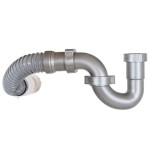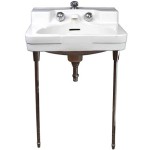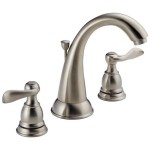Selecting the Right Sink Size for Your Bathroom
Choosing the correct sink size is a crucial aspect of bathroom design, impacting both functionality and aesthetics. A sink that is too large can overwhelm a small space, while one that is too small may prove inadequate for daily tasks. This article provides a comprehensive guide to understanding sink sizes and selecting the appropriate dimensions for various bathroom setups.
Bathroom sinks are available in a diverse range of sizes and styles, catering to different needs and preferences. Factors such as bathroom size, countertop space, plumbing configuration, and intended usage should be carefully considered before making a selection. Understanding standard sink dimensions and the implications of deviation from these norms is essential for a successful bathroom renovation or new construction project.
The following sections will delve into specific sink types and their typical size ranges, providing a framework for informed decision-making. We will also explore how to measure your available space and assess your needs to ensure you choose a sink size that optimizes both form and function in your bathroom.
Understanding Standard Sink Dimensions
While sink sizes vary considerably, some general dimensions are considered standard for different sink types. Knowing these benchmarks can help you navigate the vast array of options and narrow down your choices. The key measurements to consider are width, depth (front-to-back), and height (above the counter in the case of vessel sinks, or below the counter for undermount sinks).
For
vanity sinks
, which are the most common type, typical widths range from 20 to 30 inches. However, smaller vanity sinks, often referred to as bar sinks or prep sinks, can be as narrow as 15 inches, while larger sinks designed for double vanities or master bathrooms can extend to 48 inches or even longer. The standard depth for vanity sinks is typically between 17 and 20 inches. The bowl depth, which refers to the depth of the sink basin itself, usually falls between 5 and 8 inches. This depth is important for preventing splashing and ensuring adequate water capacity.Pedestal sinks
, known for their space-saving design, usually have a width ranging from 18 to 24 inches and a depth of 16 to 20 inches. The overall height, from the floor to the top of the sink, is typically around 32 to 36 inches, offering a comfortable height for most users. However, pedestal sinks offer little to no storage, which is a significant consideration. Therefore, if choosing a pedestal sink, ensuring you have adequate storage elsewhere in the bathroom is critical.Wall-mounted sinks
, another space-saving option, offer flexibility in height adjustment and accessibility. These sinks typically range in width from 16 to 24 inches and in depth from 13 to 20 inches. The absence of a cabinet base creates a more open and airy feel, making them ideal for smaller bathrooms or powder rooms. Careful attention must be paid to the wall structure to ensure it can adequately support the weight of the sink, especially when filled with water.Vessel sinks
, which sit atop the countertop, offer a distinctive and contemporary aesthetic. Their dimensions can vary widely, with diameters ranging from 16 to 20 inches for round models and widths ranging from 18 to 24 inches for rectangular or oval models. The height of a vessel sink is also a crucial factor, as it affects the overall sink height. Typically, vessel sinks range from 4 to 8 inches in height. When choosing a vessel sink, it is important to consider the height of the countertop and the faucet to ensure that the final sink height is comfortable for users. Furthermore, you must choose a tap which has adequate spout height to reach the top of the sink, otherwise it will be difficult to use.Corner sinks
, designed to fit neatly into corners, are an excellent solution for maximizing space in smaller bathrooms. They typically have a width and depth of around 16 to 20 inches. Their triangular or angled shape makes them an unobtrusive addition to tight spaces.It is important to note that these are just general guidelines, and actual sink sizes may vary depending on the manufacturer and specific design. Always refer to the product specifications before making a purchase to ensure that the sink will fit your space and meet your needs.
Measuring Your Bathroom Space
Accurate measurements are essential to ensure that the chosen sink fits properly and allows for comfortable movement within the bathroom. Before selecting a sink, carefully measure the available space, taking into account any existing plumbing fixtures, doorways, windows, and other obstacles.
Begin by measuring the available countertop space. Determine the maximum width and depth that the sink can occupy without encroaching on adjacent countertops or interfering with cabinet doors or drawers. If you are replacing an existing sink, measure the dimensions of the old sink and use these as a starting point. However, it is also worth considering whether a slightly larger or smaller sink would be more suitable, given your current needs.
Consider the placement of the faucet and its reach. Ensure that the faucet spout will extend far enough over the sink basin to allow for comfortable handwashing without splashing. Also, check the height of the faucet to make sure that it is compatible with the sink's dimensions, especially for vessel sinks.
Assess the location of the drain and water supply lines. If you are replacing an existing sink, the new sink should ideally align with the existing plumbing connections to avoid costly and time-consuming modifications. If you are installing a new sink in a different location, you will need to ensure that the plumbing can be easily rerouted to accommodate the new sink's placement.
Consider the overall layout of the bathroom and the flow of traffic. Ensure that the sink does not obstruct doorways, walkways, or other key areas. Allow for adequate space around the sink for users to move comfortably, especially in shared bathrooms.
When measuring for a pedestal sink or wall-mounted sink, pay close attention to the height of the drainpipe. Most pedestal sinks are designed to conceal the drainpipe, so the pipe must be located at the correct height for it to fit within the pedestal. Wall-mounted sinks offer greater flexibility in height adjustment, but it is still important to ensure that the drainpipe is properly positioned.
Once you have gathered all the necessary measurements, create a sketch of your bathroom layout, including the dimensions of the countertop, sink, and other fixtures. This will help you visualize the space and ensure that the chosen sink will fit properly and complement the overall design.
Matching Sink Size to Bathroom Style and Usage
The sink size should be carefully considered in relation to the overall style of the bathroom and the intended usage. A small powder room will have different sink requirements than a master bathroom shared by two people. Choosing a sink that is both aesthetically pleasing and functionally appropriate is key to creating a harmonious and efficient bathroom space.
In
small bathrooms or powder rooms
, space is often at a premium. Opting for a smaller sink, such as a corner sink, wall-mounted sink, or a compact vanity sink, is often the best approach. These sinks minimize their footprint, allowing for more floor space and easier movement. Pedestal sinks can also be a good choice for small spaces, but they lack storage, which may need to be addressed elsewhere in the room.For
larger bathrooms or master bathrooms
, there is more flexibility in sink size and style. A larger vanity sink with ample countertop space can provide a more luxurious and functional experience. Double vanities with two separate sinks are a popular choice for master bathrooms, offering each user their own dedicated space. Vessel sinks can also be a striking addition to a larger bathroom, adding a touch of elegance and sophistication.Consider the intended usage of the sink. If the sink will be used primarily for handwashing and quick tasks, a smaller sink may suffice. However, if the sink will be used for more demanding tasks, such as shaving or washing one's face, a larger sink with a deeper basin may be more appropriate. For bathrooms used by children, consider a sink height that is comfortable for them to use.
The style of the sink should also complement the overall aesthetic of the bathroom. A modern bathroom might benefit from a sleek, minimalist sink with clean lines, while a more traditional bathroom might call for a classic pedestal sink or a vanity sink with ornate detailing. The finish of the sink should also be considered, with options such as stainless steel, porcelain, and stone providing different levels of visual appeal.
Think about storage needs. A vanity sink provides built-in storage for toiletries and other bathroom essentials, while pedestal sinks and wall-mounted sinks lack storage. If storage is a priority, a vanity sink is the clear choice. If you prefer the minimalist look of a pedestal sink or wall-mounted sink, you will need to find alternative storage solutions, such as shelves, cabinets, or baskets.
Finally, consider accessibility. If the bathroom is used by someone with mobility issues, a wall-mounted sink or a vanity sink with open space underneath can provide easier access. Adjustable-height sinks are also available, allowing for customization to individual needs.
By carefully considering the bathroom's size, style, intended usage, and accessibility needs, you can select a sink size that optimizes both form and function, creating a bathroom space that is both beautiful and practical.

Standard Bathroom Sink Dimensions With Photos Upgradedhome Com

Vessel Sink Bathroom Vanity Sizes Counter Top

American Standard Size Sanitary Ware Bathroom Sink White Wash Basin Solid Surface Washing Vanity China Art Made In Com

B604 Rectangular Undermount Vanity Sink Bristol Sinks

Plan Your Bathroom By The Most Suitable Dimensions Guide Engineering Discoveries Small Sinks Sink Vanity

Ruvati 16 In X 11 Undermount Bathroom Sink Brushed Stainless Steel Rvh6107 The Home Depot

Mini Bathroom Sink 40 X 27 Cm Small Sinks Agile Ag40 Simas

Basin Sizes Toilet Shower Enclosure Bathroom Dimensions Durovin

Bathroom Sink Dimensions And Guidelines With 3 Drawings Homenish In 2024 Sizes

Kraus Elavo Large Rectangular Ceramic Undermount Bathroom Sink In White With Overflow Kcu 251 The Home Depot
Related Posts







